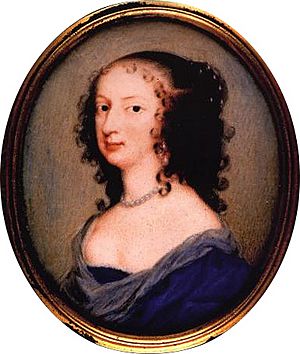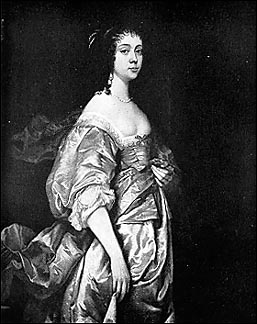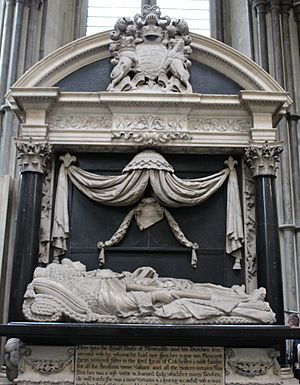Margaret Cavendish, Duchess of Newcastle-upon-Tyne facts for kids
Quick facts for kids
Margaret Cavendish
|
|
|---|---|

Portrait of Margaret Cavendish
|
|
| Born | 1623 |
| Died | December 16, 1673 (aged 49–50) |
| Nationality | English |
| Spouse(s) | William Cavendish, 1st Duke of Newcastle-upon-Tyne |
| Era | 17th-century philosophy Age of Enlightenment |
| School | Vitalism |
Margaret Lucas Cavendish, Duchess of Newcastle-upon-Tyne (1623 – 15 December 1673) was an amazing English thinker. She was a philosopher, poet, scientist, and writer of stories and plays.
Her husband, William Cavendish, 1st Duke of Newcastle-upon-Tyne, was a Royalist leader. He had to leave England in 1644 during the First English Civil War. Margaret went with him and lived abroad until 1660. She was brave enough to publish her writings using her own name. This was very unusual for women writers at that time.
Contents
- Early Life and Family
- Her Amazing Writings
- Life Challenges
- Important Books
- Her Plays
- Other Works
- See also
Early Life and Family
Margaret Lucas was born in 1623. Her parents were Sir Thomas Lucas and Elizabeth Leighton. She was the youngest of eight children. She had four sisters and three brothers. Her brothers were important Royalists.
Childhood and Learning
Margaret grew up with her siblings. She did not go to a formal school. Instead, she learned from tutors and had access to many books. She started writing down her ideas when she was young. However, it was not common for girls to show such intelligence back then. So, she kept her writings private at home.
Her family was quite wealthy. Margaret said her mother made sure they lived well. They had "honest pleasures and harmless delights."
Becoming a Lady-in-Waiting
When Queen Henrietta Maria was in Oxford, Margaret became one of her ladies-in-waiting. She traveled with the Queen when they went to France. This was the first time Margaret was away from her family. She felt shy around strangers. She worried about saying or doing the wrong thing.
Margaret wanted to leave the Queen's court. But her mother told her not to give up. Her mother also sent her extra money. Margaret stayed as a lady-in-waiting for two more years. Then, she married William Cavendish.
Marriage to William Cavendish
Margaret said her husband liked her shyness. She loved him for his good qualities, not his wealth or title. She believed these qualities helped them stay strong during hard times. Margaret and William did not have any children together. Her husband had five children from his first marriage.
Margaret later wrote a book about her husband's life. It was called The Life of the Thrice Noble, High and Puissant Prince William Cavendish. Some people thought her husband wrote her books. But Margaret said he defended her. She also said he helped her with her writing.
Her Amazing Writings
Margaret Cavendish was a poet, philosopher, and writer. She published her books using her own name. This was a big deal because most women writers stayed anonymous. She wrote about many topics. These included gender, power, science, and philosophy.
Her book The Blazing World is a very early example of science fiction. She was unique for her time. She wrote many books about natural philosophy, which is like early science. She published over a dozen original works.
Margaret Cavendish was seen as a unique and groundbreaking woman writer. She disagreed with some popular ideas in science and philosophy. In May 1667, she became the first woman to visit the Royal Society of London. This was a famous group of scientists. She talked with important thinkers like Thomas Hobbes and Robert Boyle. She also spoke out against animal testing.
Her books made her famous. They also helped show that women were not less smart than men. Margaret used her writings to support education for women. She believed women could learn and benefit from schooling. She even said her own books would have been better if she had gone to school like her brothers.
Life Challenges
Money Troubles
After she got married, Margaret went back to England with her husband's brother. She hoped to get some money from her husband's property. His property had been taken by the government because he was a Royalist. But she did not get any money. She said she only asked for funds once and decided it was not worth the trouble. After a year and a half, she went back to be with her husband.
Personality and Health
Margaret wrote about her shy nature. She called it "melancholia." She said it made her "repent my going from home to see the World abroad." This shyness made her not want to talk about her work in public. But she often made fun of it in her writing.
Beliefs about God
Margaret's ideas about God were not always clear. Her writings show she was a Christian. But she did not often write about religion. She said she believed in God. However, she wanted to keep philosophy separate from talking about God's actions. She felt that humans could not fully understand God.
Fashion and Fame
Margaret loved to create her own style. She wanted to be unique in her clothes, thoughts, and actions. She did not like to dress like other women. She also openly said she wanted to be famous. She believed it was okay to want to be better than others and achieve lasting fame.
She knew some people would criticize her for writing about her own life. But she said she wrote it for herself. She wanted future generations to know the true story of her family and life. She pointed out that famous men like Caesar had done the same thing.
Her Passing
Margaret Cavendish passed away in London on December 15, 1673. She was buried in Westminster Abbey on January 7, 1674. Her husband had a beautiful monument built for her. The words on it say: "Her name was Margaret Lucas youngest daughter of Lord Lucas, earl of Colchester, a noble family, for all the brothers were valiant, and all the sisters virtuous."
Important Books
Poems and Fancies (1653)
This book has poems, letters, and some prose. It covers topics like science, nature, and love. Her poems sometimes sound like conversations between things. For example, between earth and darkness. Margaret's maid, Mistress Toppe, said Margaret wrote stories, moral lessons, and philosophical ideas.
Why She Wrote
Margaret knew her writing was not always perfect. She said she cared more about sharing her ideas than writing beautifully. She wanted to communicate her thoughts clearly. She also said she wrote to pass the time. She felt it was a better use of her time than many other activities.
Letters to Readers
Like many writers, Margaret wrote introductions to her books. In these letters, she explained why she wrote. She often had to defend herself for writing as a woman. She asked readers to praise her work and stay quiet if they did not like it. She often used these letters to admit her writing might have weaknesses.
Writing as "Mental Spinning"
In a letter to her brother-in-law, she compared writing poetry to spinning. Spinning was a common task for women. She called poetry "mental spinning." She said she was better at writing than spinning. Margaret often used everyday female tasks to describe her writing. She also asked for her brother-in-law's approval. She believed praise would make her work seem better.
Wanting to Be Famous
Margaret clearly stated her wish for fame. She did not care if only the best people liked her writing. She just wanted many people to like it. She expected criticism, especially from men. But she argued that women who write would not gossip or act foolishly. She asked for other women's support. She said if she failed, she would be like a hero for women.
Defending Her Writing
In another letter, Margaret said fame was her main reason for writing. She again asked for her writing to be accepted, even though it went against what women usually did. She said her ambition was not "womanly." It was a quest for glory and praise. She believed her desire for fame was innocent. She also said it was easier to get forgiveness for writing without permission than to get permission first. She saw writing as better than gossiping.
Nature's Pictures drawn by Fancy's Pencil to the Life (1656)
This book mixes different types of writing. It includes short stories. These stories often show women in interesting ways.
A True Relation of my Birth, Breeding, and Life (1656)
Margaret published this story about her own life when she was 33. She wrote it to explain herself to people. She wanted to correct what others were saying about her. The book tells about her family, her childhood, her education, and her marriage. It also shares her personality and goals. She talks about her shyness and her love for writing.
The book also describes the hard times her family faced because of the Civil War. They lost property and loved ones.
CCXI Sociable Letters (1664)
This book is a collection of letters. They are written as if real women wrote them. The letters cover many topics. These include marriage, war, politics, science, and books. Some letters seem to be about real people. But most are fictional. They give a lively look at life in her time.
Observations upon Experimental Philosophy (1666)
Her Ideas on Science
Margaret Cavendish wrote six books about natural philosophy (science). This was rare for women in the 1600s. She had her own ideas about how the world worked. Her husband and his brother were interested in science and supported her studies. She also learned from talking to other thinkers.
Many people criticized Margaret's work. But she also received praise. Her husband wrote poems and letters praising her.
Writing as a "Disease"
In her introduction to this book, Margaret said people might call her writing too much a "disease." But she said many famous men like Aristotle and Homer had the same "disease." She felt it was an honor to share this with such wise men. She said she wrote for herself and that it was a harmless hobby. She also said she wrote for fun.
Brains vs. Learning
Margaret wrote that women's natural intelligence might be equal to men's. She believed women could learn just as easily. She argued that intelligence is natural, but learning comes from education. In her time, men had more chances to get an education than women.
She also advised science writers to use simple language. She thought complex words made it harder to understand. She wanted her own work to be easy for everyone to read, no matter their education. She asked readers to focus on her main ideas and overlook any small mistakes.
The Description of a New World, Called the Blazing World (1666)
This story was published with Observations upon Experimental Philosophy. It is an early example of science fiction. It explores ideas about science, gender, and power. Margaret even wrote herself into the book as an empress. She said she would be known as Margaret the First.
Her Plays
Margaret Cavendish published two collections of her plays. Her plays were never performed during her lifetime. But some, like The Convent of Pleasure, have been staged since then.
Plays (1662)
This book includes:
- Loves Adventures
- The Several Wits
- Youths Glory, and Deaths Banquet
- The Lady Contemplation
- Wits Cabal
- The Unnatural Tragedy
- The Public Wooing
- The Matrimonial Trouble
- Nature's Three Daughters, Beauty, Love and Wit
- The Religious
- The Comical Hash
- Bell in Campo
- A Comedy of the Apocryphal Ladies
- The Female Academy
Plays, Never Before Printed (1668)
This book includes:
- The Sociable Companions, or the Female Wits
- The Presence
- Scenes (edited from The Presence)
- The Bridals
- The Convent of Pleasure
- A Piece of a Play
Other Works
Margaret also published Philosophical Letters (1664) and a collection called Orations (1662). Many of her books discuss science, gender, power, and manners. She often included introductions where she talked about her work and her goals. She also told readers how to understand her writing. Her work has been both praised and criticized since it was first published.
See also
 In Spanish: Margaret Cavendish para niños
In Spanish: Margaret Cavendish para niños
- List of animal rights advocates







